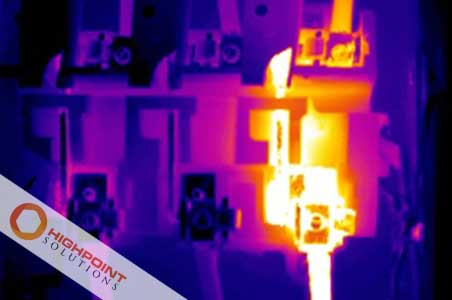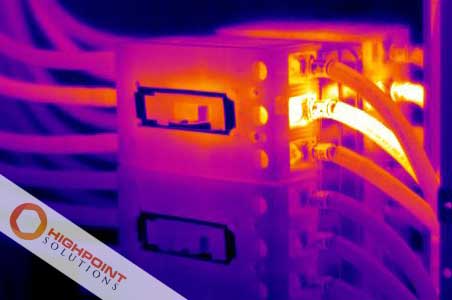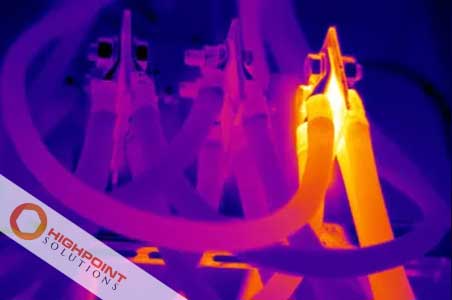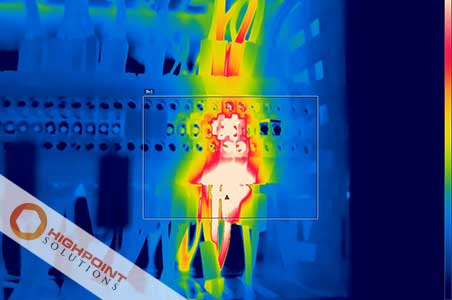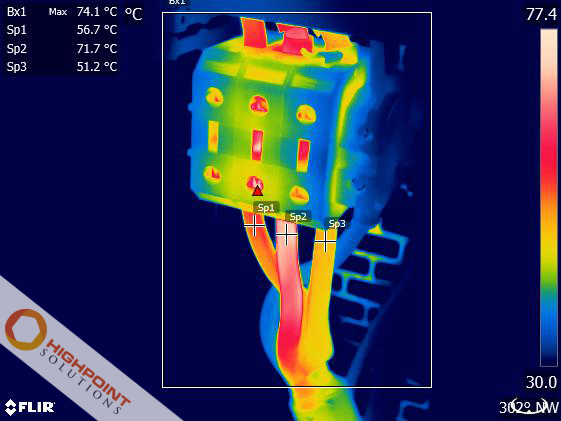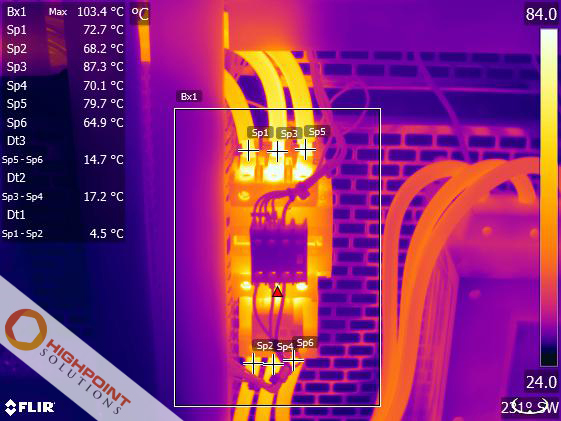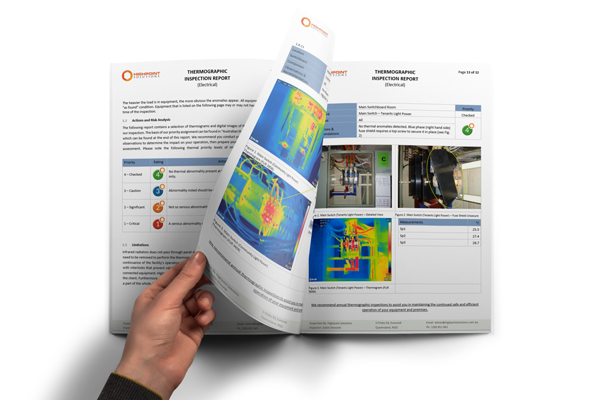
Annual Thermal Imaging Inspections for Electrical Switchboards – Has Your Insurance Company Requested One?

Grrr! There appears to be a trend developing. You know, your insurance underwriter is asking you to provide an annual thermographic inspection of all your electrical switchboards and components. It’s a pain, we know. But why are the insurance folks making this demand? That’s simple to answer. It’s called Risk Mitigation.
In other words, the insurance company is attempting to cover their butt, which makes sense, really. You have income protection and auto insurance to cover your ass-ets should something go sideways on your morning commute. The insurance company should be allowed to do the same.
So what do you do to help your insurance company so they’ll leave you alone for another year? Simple. You turn to Google and search for “where is my local thermal imaging guy located” or something like that. You’ll end up with a number of results listing several thermographers and as is typical in Human Nature, you pick the cheapest one because well, a thermographer is a thermographer…right?
Well, not exactly.
Here’s where I get to share some really cool knowledge with you. I’ve done the search. I’ve visited and analyzed several thermal imaging company websites. You know, checking out what their web content says about their services and checking out the thermograms (that’s the thermal images). What I’ve discovered is that about half of these so-called ‘thermographers’ don’t have much of a clue about thermography or electrical thermography.
Oh, don’t be too shocked at that statement because many of the thermography training services out there offer rather um, inferior training. Hey, here’s a fine example: some of these training facilities allow you to get your certification online. That’s like getting your drivers license online or a pilot who gets his wings just from reading a couple of online manuals and using his Playstation 4 for flight simulation. Yikes!
Hiring a thermography is a whole lot like hiring a wedding photographer. That is to say, you get what you pay for. Thermography is important enough that you need at least the first guy on site to know what he is doing as you don’t want a missed – translation: potentially critical – thermal anomaly to lead to a catastrophic result at either your client’s property or at your business.
How Hard Can It Be To Find A Hot Spot In An Electrical Distribution Board?
That answer rests squarely on who you hire and I’ll give you more on that later. That’s because this is what writers call a classic ‘teaser’ which should cause you to hang around here until I get to the answer.
So, to add some more value to the content you are reading, I am going to review a few terms that you may encounter as part of the thermography journey. I am going to try very hard to stay as non-technical as possible because this can get a bit dry.
Emissivity
The emissivity of the surface of a material is its effectiveness in emitting energy as thermal radiation. Thermal radiation is electromagnetic radiation and it may include both visible radiation (light) and infrared radiation, which is not visible to human eyes. The thermal radiation from very hot objects is easily visible to the eye. Quantitatively, emissivity is the ratio of the thermal radiation from a surface to the radiation from an ideal black surface at the same temperature as given by the Stefan–Boltzmann law. The ratio varies from 0 to 1. The surface of a perfect black body (with an emissivity of 1) emits thermal radiation at the rate of approximately 448 watts per square metre at room temperature (25 °C, 298.15 K); all real objects have emissivities less than 1.0, and emit radiation at correspondingly lower rates.
Read more here if you must: https://en.wikipedia.org/wiki/Emissivity
FOV or Field of View
This is the largest area that your imager can see at a set distance. It is typically described in horizontal degrees by vertical degrees—for example, 23º X 17º. (These “degrees” are units of angular measurement, not to be confused with the degrees of temperature measurement.) Essentially, it is like a rectangle extending out from the center of your camera’s lens extending outward. The farther away you look, the larger the rectangle becomes itching for an analogy? Think of Field of View as the windshield that you are looking out as you drive your automobile down the road. You can see everything from top of the windshield to the bottom, and from the left to the right.
IFOV or Instantaneous Field of View (otherwise known as Spatial Resolution)
This is the smallest detail within the FOV that can be detected or seen at a set distance. What does this mean? It means that at certain distance, you may not be able to see certain small details if your Spatial Resolution is not good enough. IFOV is typically measured in units called milliradians (mRad). Milliradians are small fractions of an angular degree. To continue the driving analogy, think of IFOV as the ability to see a roadside sign in the distance (through your windshield). You can see that it is a sign, but you may not be able to read it when it first becomes recognisable.
IFOV measurement or Instantaneous Field of View Measurement (otherwise known as Measurement Resolution)
This is the smallest detail that you can get an accurate temperature measurement upon at a set distance. Going back to our analogy again… when you see a sign in the distance, and you cannot read it, what do you do? Pretty obvious, huh? You either move closer, or you use some type of optical device, such as binoculars, to effectively “bring you closer”. The same is true in infrared thermography. Assuming that you do not have the power to make the object itself bigger, in order to “read” the temperature measurement more accurately, you usually need to be closer to the object… either physically or optically. IFOV measurement, or Measurement Resolution, is also typically specified in milliradians, and it is often two to three times more than the specified Spatial Resolution.
Are You Still With Me? Here’s Why It All Matters
The whole point in explaining the terms for you is to give you some knowledge base to work with. That’s because all of these factors matter a great deal and can directly affect the thermographer’s ability to provide you with accurate thermographic inspections of your assets.
This also means that the thermographer has to understand his or her theory as well and the capabilities of the camera. They also have to be able to work within those physical and optical limitations in order to see potential problems and obtain accurate temperature measurements (when they are important to your application). Conversely, this means that some infrared cameras may not be suitable for the task based solely on their low specifications.
The Bottom Line
Well, you have to be able to weed out the wannabes from the real deal when you are looking for a thermography company to inspect your electrical assets. How do you do that? Well, I have an idea. You need to ask them some questions but not just any question.
Here’s a list of questions I would ask:
Are you a certified thermographer?
Yep, it sounds far too basic, but you really need to know what you are getting into from the get-go. If the answer to this question is a yes, ask that they prove it to you by showing you their certification paperwork.
Do you have insurance coverage?
This is where you need to find out if they have all of the appropriate coverages that will protect everyone concerned for the job they are performing. Again, if the answer is yes, ask to see their Certificates of Currency.
Do you have experience in this field?
You don’t want a guy (or girl) crawling around your stuff who aren’t really experienced in thermography.
How long has your company been in this business?
Sure, this doesn’t mean that if the company you hire just started operations isn’t going to have some experienced staff working for them, but you still want to be assured that these guys have been around for a while. You don’t want to be their first-ever customer, if you know what I mean.
Do you have relevant administrative documentation to ensure the work is carried out in a safe manner?
Again, this should be one of many no-brainers but you have to ask as you don’t want to assume and be wrong. The paperwork they should be able to show you will include such things as SWMS’s, JHA’s and assorted other procedural documents.
Here’s the real kicker.
If the prospective thermal imaging guy (or girl) you are quizzing with these questions says ‘no’ to all of the above five questions, you have an option. You could just go to eBay, purchase the cheapest kaleidoscope you can find and do the job yourself or, you could just call my crew to take care of it for you.
Highpoint Solutions deliver world-class electrical thermography services to commercial and industrial clients throughout Australia. Give our office a call to discuss how we can meet all of your thermography requirements.
Recent Posts


